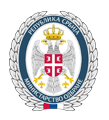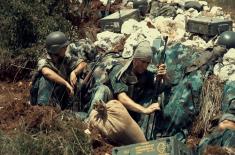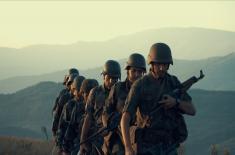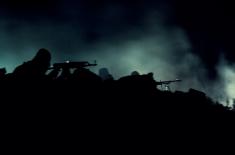Battle Of Paštrik
BATTLE OF PAŠTRIK
26 MAY – 14 JUNE 1999
26 MAY – 14 JUNE 1999
When it became clear that the enemy could not break through the line of our defence in the area of the Košare border outpost, a new KLA terrorist attack on Mount Paštrik began. The KLA’s attempted land offensive, aided by NATO forces, but also by regular Albanian Army units, began with an attack on the Gorožup outpost, which is located near Prizren.
Major General Božidar Delić, Commander of the 549th Motorized Brigade: The goal was to make a breakthrough along the Drim-Kosovo operational route at any cost, to seize Prizren, continue through the Dulje pass to Kosovo and put the Federal Republic of Yugoslavia at a disadvantage when the ceasefire negotiations begin. "
In the early morning hours of 26 May 1999, an attack on Yugoslav Army positions began. A front about six kilometres long was established. Numerous enemy troops attacked our positions, where at the time of the attack there were about 400 soldiers, frontier sentries from the 55th Border Battalion and members of the 549th Motorized Brigade.
Major General Božidar Delić, Commander of the 549th Motorized Brigade: "So, the most intense fighting was near the Gorožup border outpost. They captured the top of Mount Paštrik, and even when we recaptured the entire territory, we did not want to recapture the top of Paštrik precisely because of enemy aircraft. If we had been at that top, they would have simply wiped out all our men with a couple of bombings or by firing A 10 aircraft guns. One day, the Gorožup outpost was seized and the men, frontier sentries and volunteers, withdrew 300 metres from the outpost, because I ordered them to do so, and an hour later, the frontier sentries called me and said that they had returned to the vicinity of the outpost and that they only needed to make one more 50-meter jump, drop bombs, and get back to their trenches. In fact, they could not return to the outpost because it was just a pile of stones. And about 10 to 15 minutes later, they reported "the outpost is ours".
On the same day, a forward command post was established, so that the officers leading the forces would be as close as possible to the front line. By the end of the evening, new Yugoslav Army troops arrive in Paštrik. The front stabilizes and in the following days all KLA terrorists who had managed to infiltrate into our territory on the first day of the attack were expelled from the territory of Yugoslavia.
Brigadier General Stojan Konjikovac, Commander of the Paštrik Forward Command Post: "After the arrival of reinforcements, we had about 1,000 soldiers in total, 600 to 700 soldiers at the border itself. In the days after the stabilization of the situation on the front, fighting took place every day until 31 May".
Major General Božidar Delić, Commander of the 549th Motorized Brigade: "For the first time, we had night attacks on Paštrik. Why did they decide to attack at night? Their every attack was largely stopped by artillery fire. So, our infantry on the front line was never without fire support. That is why they started night attacks, because at night they could get close to, as we say, the range of a hand grenade. And then there would be an intense exchange of fire, they would launch an attack and sometimes they would organize and execute 3 to 4 attacks in one night and they would be stopped each time by either artillery fire or even bombs. We had something specific, "Vihor 1"anti-personnel directional fragmentation mines, which we manufactured in Prizren and which caused, so to speak, a massacre in enemy ranks. Because these mines weighed about 70 kilograms, with 9 kilograms of explosives and 35 kilograms of mine fragments travelling several hundred metres and destroying everything in their path. And there were a lot of them in Paštrik, because we manufactured them in series of 100 pieces each."
The Yugoslav Army troops inflicted heavy losses on the enemy. According to the official data of Kosovo’s Commission on recognition and verification of the status of veterans, 453 members of the KLA were killed in the Paštrik area of operations, and more than 700 were wounded. The enemy had 20 times greater losses. When it was clear that the infantry attacks of the KLA terrorists did not yield results, NATO started bombing the Yugoslav Army positions. Strategic aviation that can carry nuclear bombs was also deployed. The 549th Motorized Brigade was the only unit that was carpet bombed in those days.
Twenty-six members of the Yugoslav Army were killed in Paštrik, and more than half of them were victims of NATO air strikes.
 PHOTOGALLERY
PHOTOGALLERY



